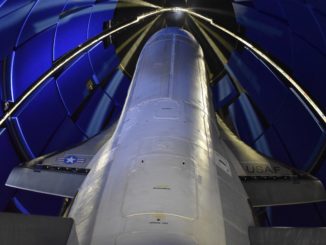
CAPE CANAVERAL — With the Delta 4 rocket now waiting on the launch pad, its Air Force Wideband Global SATCOM communications satellite payload has jetted from the Los Angeles factory to the Cape Canaveral in preparation for liftoff this summer.
The Boeing-built WGS 7 spacecraft arrived May 28 at Kennedy Space Center’s Shuttle Landing Facility runway aboard a military cargo transporter aircraft. It was taken to the commercial Astrotech processing hangar in nearby Titusville to begin testing, fueling and encapsulation.
A United Launch Alliance Delta 4 rocket will boost the satellite into a super-synchronous transfer orbit on July 22 from Cape Canaveral Air Force Station.
The $566 million craft will join a half-dozen other WGS satellites already in orbit 22,300 miles up that provide the backbone communications infrastructure for troops, ships, drones and civilian leaders virtually anywhere on the planet.

The Boeing Company is building 10 WGS satellites to relay high-data-rate, large-volume communications such as voice, video conferencing, intelligence files and weather data for the U.S. and allied military forces.
“The WGS constellation provides highly capable military communications that leverages cost-effective production methods and the latest technological advances,” said Lt. Gen. Samuel Greaves, the Air Force’s program executive officer for Space. “It takes a lot of hard work by the joint Air Force and contractor team to make this mission a success.”
The WGS constellation is augmenting and eventually replacing the aged Defense Satellite Communications System network. A WGS satellite has 10 times the capacity of a DSCS bird.
The sophisticated WGS spacecraft are constructed around Boeing’s powerhouse 702HP-model design used by commercial satellite operators. But within the WGS are Ka- and X-band military communications packages.
The Delta 4 rocket for the upcoming WGS 7 launch was rolled out from its Horizontal Integration Facility to the pad at Complex 37 on May 26. It was erected the next day.

The following days saw the four strap-on solid-propellant boosters attached to the first stage and the pre-launch testing procedures get underway. The satellite will be mated to the rocket in early July.
The vehicle will fly in the powerful Medium+(5,4) configuration with a five-meter upper stage and payload fairing and the four solids. ULA rockets have deployed the entire WGS constellation.
Liftoff is planned for July 22 during a window of 8:07 to 8:52 p.m. EDT (0007-0052 GMT).
It will be the 372nd Delta rocket launch since 1960, the 30th Delta 4 rocket since debuting in 2002, the fifth time a Delta has launched a WGS communications satellite, ULA’s 98th mission since 2006 and the company’s seventh this year.
See our earlier launch coverage.
Our earlier Delta archive.



